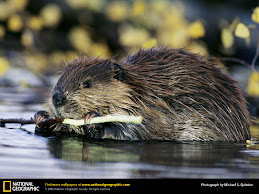skip to main |
skip to sidebar
 For those of us who think full-time about nature and the environment, it seems every story is worse than the one before. The Arctic is melting, species vanishing, forests declining, and so on… So I was thrilled this week by the Philadelphia Inquirer’s front page story on the Atlantic sturgeon, an extraordinary and extraordinarily ancient animal—cruising our waters since the Age of Dinosaurs—that was once a commercially important fish.
For those of us who think full-time about nature and the environment, it seems every story is worse than the one before. The Arctic is melting, species vanishing, forests declining, and so on… So I was thrilled this week by the Philadelphia Inquirer’s front page story on the Atlantic sturgeon, an extraordinary and extraordinarily ancient animal—cruising our waters since the Age of Dinosaurs—that was once a commercially important fish.
As reported here, a biologist doing research in the Delaware River near Wilmington pulled in a net overflowing with piles of the pedestrian perch. Then he spotted a standout: a baby Atlantic sturgeon, hatched just this year.
Only seven inches long, Sandy Bauers writes “it was nevertheless a momentous discovery—long-awaited proof that the species was spawning in the Delaware.”
As the story recounts, sturgeon “was once the basis of a thriving caviar industry on the Delaware, the nation's largest. In the late 1800s, the river swarmed with boats and nets during spawning season, the shores were lined with cleaning stations. Then, largely because of overfishing and pollution, the population of Atlantic sturgeon plummeted to near-extinction in the early 1900s.”
The animal craves clean water, and has the kind of biology that typically dooms critters: long-lived animals themselves—and big, they get to be about 14 feet long—they become sexually mature only after almost two decades, a horribly long period of time.
As WHYY reported just this morning, this is the first record of a spawning sturgeon in the Delaware in 50 years.
Hope springs eternal.
Bad news from the north: ScienceDaily (Sep. 11, 2009) — "The Arctic as we know it may soon be a thing of the past," says Eric Post, associate professor of biology at Penn State University. Post leads a large, international team that carried out ecosystem-wide studies of the biological response to Arctic warming during the fourth International Polar Year, which ended in 2008. The team's results will be reported on 11 September 2009 in the journal Science.
ScienceDaily (Sep. 11, 2009) — "The Arctic as we know it may soon be a thing of the past," says Eric Post, associate professor of biology at Penn State University. Post leads a large, international team that carried out ecosystem-wide studies of the biological response to Arctic warming during the fourth International Polar Year, which ended in 2008. The team's results will be reported on 11 September 2009 in the journal Science.
The team's research documents a wide range of responses by plants and animals to the warming trend. The scientists found that the increase in mean annual surface temperature in the Arctic over the last 150 years has had dramatic effects. In the last 20 to 30 years, for example, the seasonal minimal sea ice coverage has declined by a staggering 45,000 square kilometers per year. Similarly, the extent of terrestrial snow cover has declined steadily, with earlier melting and breaking up and an earlier start to the growing season.
"Species on land and at sea are suffering adverse consequences of human behavior at latitudes thousands of miles away," declares Post. "It seems no matter where you look -- on the ground, in the air, or in the water -- we're seeing signs of rapid change."
To read more of this very important study, click here.
 Working in my side garden’s milkweed patch this week, a color combination unconsciously caught the corner of my eye, and my head snapped over. There, hanging head-down along the spine of a milkweed leaf was a very large, likely very happy monarch caterpillar.
Working in my side garden’s milkweed patch this week, a color combination unconsciously caught the corner of my eye, and my head snapped over. There, hanging head-down along the spine of a milkweed leaf was a very large, likely very happy monarch caterpillar.
Only a few feet away crawled another. Eureka!
You know monarchs, those big orange-and-black flutterers, all Halloween-striped. I’m a Philadelphian, so here’s my frame of reference: they wear Flyers jerseys. But the youngsters are striped like shown here: white, yellow, black. Bold. Dramatic.
Monarchs are ace botanists, only laying their eggs on milkweeds, nothing else. After hatching, the young immediately set to work devouring their world, plowing through milkweed leaves as fast as they can.
After all, that’s all they eat, breakfast, lunch, snack and dinner for several weeks—milkweed. They incorporate the weed’s noxious latexy chemicals into their own body, and gross out any unsuspecting blue jay that tries to eat them.
That’s why I keep the milkweed patch I inherited from the previous owner on the side of the house. Thought the stuff gets to be almost 6 feet tall, it provides sustenance to monarchs.
More milkweed, more monarchs in the world.
And these were the first had seen this year. Eureka!
So, got milkweed?
You can: simply go to http://www.lmconservancy.org/ and order your own milkeweed today!
p.s. And when these two larvae metamorphose into adults, this is the generation that will fly to Mexico, a stunning feat of migration for such a small critter.
 For those of us who think full-time about nature and the environment, it seems every story is worse than the one before. The Arctic is melting, species vanishing, forests declining, and so on…
For those of us who think full-time about nature and the environment, it seems every story is worse than the one before. The Arctic is melting, species vanishing, forests declining, and so on… 


